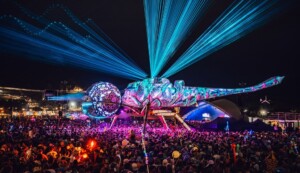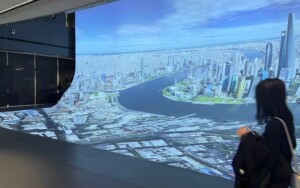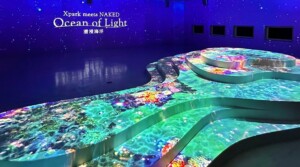September 12th at IBC 2016 in Amsterdam, marked the second stop of Ang Lee and his “whole shebang” world tour of his upcoming release Billy Lynn’s Long Halftime Walk. The movie is set to create new milestone in cinematic presentation quality using the latest technology to deliver stunningly crisp, realistic images and an immersive, intimate experience.
 By Martin Howe (left), CEO TEQ4 Limited
By Martin Howe (left), CEO TEQ4 Limited
The “whole shebang” phrase was coined by multi-Academy-Award-winning Director Ang Lee (Brokeback Mountain, Life of Pi) and his team to describe what’s going into these special screenings of this milestone movie.
In the process of deciding what format to shoot and which formats to release they ended up going all-in; 3D at 120 frames per second (per eye), 4k resolution, 6P laser illumination, 28 foot-lamberts (per eye) with a high dynamic range version too. That’s everything. Nothing left on the table. All the option boxes ticked. Oh, and for this screening, a world’s first; this was accompanied by a full-on Dolby Atmos installation too. All as a one-off installation in an auditorium and not a cinema theater. That’s a lot of heavy lifting. I was hoping it was worth it and expecting that it would be.
 Spoiler Alert
Spoiler Alert
Based on the best selling novel by Ben Fountain Ang Lee’s movie tells the story of an Iraq war hero whose homecoming ceremony reawakens traumatic memories of the battlefield and loss.
I’ll start by answering the question that’s on everyone’s lips; what was it like? It was an overwhelmingly realistic and intimate, immersive, first person experience. I thought. And so did everyone I spoke to afterwards. I’m sure Ang Lee would be pleased to hear that. Because, that was exactly his intention. He told us so, in a very humble way, in the prelude to our special screening and during a very informative panel session afterwards. It was also different, very different, to what we’re used to.
Mash-Up
Ang Lee laughed when he shared with us his idea for the section of the film we saw. “What would happen if we jump between the Thanksgiving football halftime show featuring Destiny’s Child, and the battlefield of Iraq?” He asked. “Might be interesting”, he chuckled. Yes, it might be interesting if it was presented at only 6 foot-lamberts in 2k at only 24fps. But in the whole shebang mode this mash-up was emotional.
While Beyoncé and her girls were strutting and wriggling along to the rhythm of ‘Lose my Breath’ at the stadium, I was losing my breath each time they cut back to the battlefield. I was there. It was scary. Loud, and clear, and full of detail. Sweat, dust, rocks, clouds, tyre tread, buttonholes in their helmets (no, I don’t know why either), thick black smoke in the distance, fear and panic in their eyes. And blood, deep red thick blood. Everything. On every inch of screen. All the time. Nowhere to hide. Not in this ultra-clarity whole shebang mode with all the filters off.
Up Close and Personal
Having all the normal movie filters turned off, is not always a good thing though! As Ang Lee explains, even the acting comes under the magnifying glass. You can see into their eyes, and in turn, see in to their minds. Just like you can in real-life. You can see the difference, if there is any, between what they’re acting and what they’re feeling. This was significant. It meant Lee had to direct all the time, repeatedly, until he was confident that the actor was ‘in-the-scene’. Because if they weren’t we’d see it.

And we did. Thankfully from only a couple of minor parts. Billy and his boys delivered though. They were there, in the thick of it. In body and mind. And because of that, so were we. I was exhausted watching it and I’m even exhausted now remembering it! That shot with the shoulder mounted rocket launcher. Click. Whooompf. The ground shook, I shook. A dust cloud radiated across the ground driven by the shockwave. The sound radiated across the theatre in perfect harmony. Now I’m sweating.
Thick Black Smoke
There was something burning in the distance, off to one side of the action. Throwing up, what I first though, was thick black smoke. But it wasn’t. It was black and grey and wispy, dispersing into the air around it. Burning tyres? Oil? That kind of smoke. What?! I found myself contemplating what it was that was burning, while centre screen, Bravo Squad were preparing to engage the enemy. In any other format I’d have just seen smoke. End of. This film, in this whole shebang format, I know I could enjoy time and time again, and for certain, see something different, something more, each time.
Ang Lee and a Long Journey

It was a real privilege to have this experience, to see the whole shebang and then listen to some of the production team share their thoughts of their learning journey. Ang Lee started. He told us that he saw James Cameron’s very slick educational piece on why high frame rate reveals more, especially in 3D, and that drove him to plan to shoot at 60fps for this film. Then Lee saw 120fps. Where? He didn’t say. At a theme park maybe. There are a few stunning examples of 120fps already out there in the parks. Or Doug Trumbull’s equally informative UFOTOG, a short piece created at 120fps per eye, to demonstrate the format.
 The thing is, there are very few places to see 120fps 3D 4k. Simply because, presently, there’s only one projector that can do that. And that’s Christie’s Mirage 4KLH 4K 120Hz 3DLP 3D RGB laser projector head. Yes, that’s a long product name, but it’s a whole shebang product; all the options ticked. It’s the laser version of the well-known 4k resolution Mirage, as such it’s powered by the brightest illumination system available, Christie Freedom. At IBC, 2 heads were used for a 6P (6 primary colour) set-up which can go up to 120, 000 lumens, however 72, 000 lumens were needed for Lee’s brief of 28 foot-lamberts on a unity gain screen, 12.5 meters wide screen.
The thing is, there are very few places to see 120fps 3D 4k. Simply because, presently, there’s only one projector that can do that. And that’s Christie’s Mirage 4KLH 4K 120Hz 3DLP 3D RGB laser projector head. Yes, that’s a long product name, but it’s a whole shebang product; all the options ticked. It’s the laser version of the well-known 4k resolution Mirage, as such it’s powered by the brightest illumination system available, Christie Freedom. At IBC, 2 heads were used for a 6P (6 primary colour) set-up which can go up to 120, 000 lumens, however 72, 000 lumens were needed for Lee’s brief of 28 foot-lamberts on a unity gain screen, 12.5 meters wide screen.
Then Ang Lee saw 120fps
I was fortunate to be standing alongside Trumbull when he presented UFOTOG, at our GSCA (Giant Screen Cinema Association) event ‘way back’ in 2014 in Toronto. Same Laser illuminated Mirage’s with all the options. That was our own whole shebang moment. I too came away thinking that this is the future. Wherever it was, Lee saw ‘120’ and knew he had to start there.
And like any great boss, he knew he needed a great team too. Alongside Ang Lee on stage were a team that had the cool swagger that comes from knowing they’ve just pulled-off something very big, very significant. And only occasionally did their expressions reveal that this was a mountain that they had just scaled. Technical supervisor Ben Gervais, editor Tim Squyres ACE, Sony Pictures Entertainment’s Head of Production Technology Scot Barbour. Thank you for sharing guys.
 Skillful moderator Julian Pinn, summed it up best; “You’ve made history. This is a movie milestone that will stand alongside talkies and colour”.
Skillful moderator Julian Pinn, summed it up best; “You’ve made history. This is a movie milestone that will stand alongside talkies and colour”.
Big Data
A world’s first like this is not without its challenges. Gervais’s can-do approach must have been a key component to the project’s success, as well as his strategy that he set-out from the start; “stay with commodity hardware and software”. Well at this level there can’t be a lot of commodity kit around, but that’s why the timing of this project is so significant. The equipment and software are available. Only just, but they are available along with the necessary expert technical support to get the best out of them.
7.5 Terabytes of raw data per day. In the field. With three parallel pipelines for dailies. Which take 12 to 18 hours to turnaround. Daily. Yes, there’s a lot of data. Gervais made light of it, Barbour’s eyes revealed that this was a challenge. But who thought it wouldn’t be? This is 40 times more pixel data than 2D 24fps 2k.

Well done Sony. Well done team.
And in this temporary theatre Christie’s unique ultra-high bandwidth image processing (1.2 GPix/s) from their TruLife electronics platform allowed the projectors to handle this extreme data rate. Two 7thSense Delta Infinity Media Servers, one of few, if not the only, server capable of this level of performance, carried out the important task of delivering all those pixels; uncompressed 4:2:2, 10 bit DPX files, from 48 1TB solid state drives. Yes, 48TB, but that was enough to show the entire movie. Which they will do on the next leg of their tour at the New York Film Festival on October 14. Like the Mirage projectors, the servers from 7thSense seriously push the boundaries and have already been proven in other demanding applications such as major theme parks, visitor attractions, live events, digital domes and big screen cinemas.
 Rocks in the Road
Rocks in the Road
Squyres clearly had fun with this project. He probably had a few of his own challenges too. Because this is different. So different that very few traditional film ‘rules’ apply. You can’t use make-up, it’s too obvious. But you can cut less. Because there’s more detail to absorb, to get drawn into, you can dwell on an actor for longer. They also learned that at times it’s better to stay on the listener of the dialogue, to see their facial inflections, to feel their reactions, than to cut back-and-forth to the actor speaking.
The cutting was carried out in 3D at 60fps, 2k resolution. They didn’t have the set-up to do that post-work and view it at 120fps (though Squyres did end up with a pair of Mirage projectors in his studio!) So they had to make informed guesses. And carry on learning. They realised that they needed to modify the machine guns to add realistic recoil, such was the clarity. In fact, Ang Lee wanted to use live ammo’, but didn’t get his way. Probably just as well. Even the shots inside the vehicle needed more detail. Normally the goal is to keep everything steady to reduce blur. Not here, Lee even placed rocks in the road, literally, to make the Humvee bounce more. To get more realism.
Bandwidth x Passion + Expertise = Intimacy
So what’s the result when you combine this technology bandwidth with this level of passion and expertise? Intimacy. Ang Lee and the team used this word repeatedly. And so did those who watched. There was a connection with the actors, with the scenes, the action, and with the emotion. An intimacy that was revealed because all of the traditional filters had been lifted. It was engrossing and immersive. Enjoyable. Personal and intimate.
.jpg)
Synthetic Shutters, thank goodness!
What’s a synthetic shutter? It’s the thing that means that millions of people will be able to re-live Billy Lynn’s experience in one format or another. As many readers will know, 120/4k/3D is far outside the capability of today’s cinema projectors and servers and even, surprisingly (though hopefully not for long), of DCI standards, and therefore won’t play in a typical digital cinema.
So this whole-shebang treat will only be for the eyes of the lucky few. For now. But fear not. The entire strategy for the film was to capture all the detail possible at 120fps with a 360-degree shutter, and then redact, skilfully and artistically, the amount of data to suit a range of playback formats suitable for distribution. Current targets are 3D at 60fps in 2k, 3D at 24fps in 2k and even 120fps in 2D, plus a high dynamic range version to suit Dolby Vision, I presume.
 24-Plus
24-Plus
But rather than just press a conform button to squidge all that content into the various digital containers, the talented team are busy putting the finishing touches to hand-crafted, re-created, versions of each. Much of this is done with the aforementioned synthetic shutter, called TrueMotion™, a software technology from RealD, that allows the editor to decide how much shutter to apply and even to choose the shape of the shutter. What this does is add blur, and remove a little detail. As I mentioned before, there are some scenes that could do with a little less. Having all the data to start with allows the creative team to pick and choose what look to apply where.
We saw a demonstration of how effective this was with a couple of test clips. ‘24-plus’ is the term they used for content played back at 24fps but edited down from 120fps using blended shutter settings. It was strikingly obvious how much more detail 24-plus had than just plain old 24! That’s a game changer in itself. It will be fascinating and highly informative to watch each version. That’s certainly my goal.
We’re in the Future, at last
I made this point last year. 2015, I wrote in another article, was ‘the year of the future’. All those things that we imagined would be around us, are. Robots, self-driving cars, VR, AR, smart watches, information everywhere, etc. OK, some of these are nascent, but this is where the future starts. Finally. It’s taken a while, but we’re here. Now that we’re in the future, everything is possible.
Billy Lynn’s Long Halftime Walk is another shining example of that. An experiential example of the new normal. What happens from here on, will refer back to this milestone. And trickle out, into other consumer experiences; theme parks, museum theatres, product launches, flying rides, and yes, the home. In fact, let’s not forget, that the technologies that allowed this whole shebang presentation, came from innovations driven by the attractions industry. This virtuous circle of innovation (example: theme parks), standardisation (example; DCI cinema) and commoditisation (example: home) continues on, but it’s moving at quite a pace now, isn’t it?
So? What’s next?

The public get to judge for themselves later this year. I expect it will be difficult, but informative, to measure the reaction to each of the formats, to understand what impact these presentation modes have on the audiences’ enjoyment of, and engagement with, the film.
 I do think that this new quality of presentation would benefit from its own moniker. It’s so different that consumers need to recognise it as something new. Without that, the risk is that some will say it looks like video. But it doesn’t. Ang Lee is rightly emphatic on that point. Nor does it look like film (unless the director chooses to crank-in a lot of shutter). ‘Cinema 2.0’, ‘Immersive Cinema’, ‘120/4k’, ‘60, 2k’. Simply ’HFR’. It doesn’t matter what. Without a clear label, I fear that this milestone might get blurred in history. Which would be a shame, now that we have all this clarity.
I do think that this new quality of presentation would benefit from its own moniker. It’s so different that consumers need to recognise it as something new. Without that, the risk is that some will say it looks like video. But it doesn’t. Ang Lee is rightly emphatic on that point. Nor does it look like film (unless the director chooses to crank-in a lot of shutter). ‘Cinema 2.0’, ‘Immersive Cinema’, ‘120/4k’, ‘60, 2k’. Simply ’HFR’. It doesn’t matter what. Without a clear label, I fear that this milestone might get blurred in history. Which would be a shame, now that we have all this clarity.
As for Ang Lee? He’s clear. He’s got the 120 bug and knows that he’s only just started to tap into its creative opportunities with this first venture. Expect more.
Images: Courtesy Tristar Pictures, Christie Digital, IBC 2016














